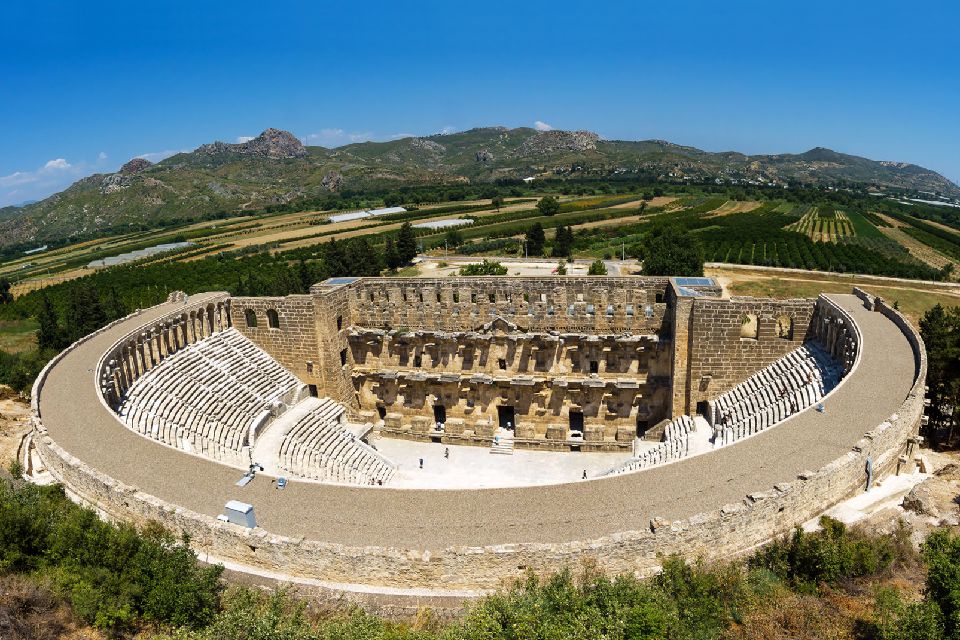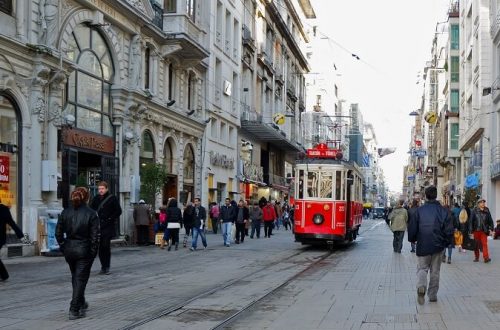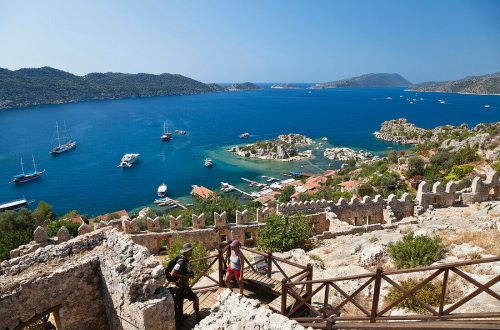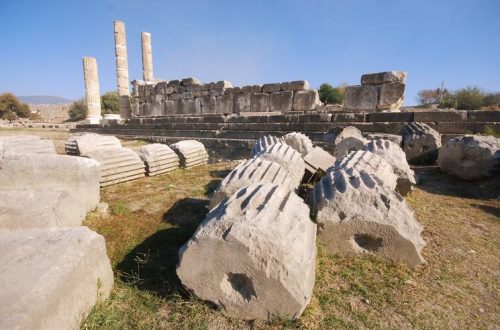
Aspendos
Aspendos: The ruins of the theatre and the old trading town.
The ruins of Aspendos are located on the south coast of Turkey, between Antalya and Manavgat.
In ancient times, the city was one of the region’s most prosperous trading centres.
Today Aspendos is best known for its well-preserved amphitheatre.
In this post, I would like to give you an overview of Aspendos, its history, sights, the theatre and current events:
A trip to the ruins of Aspendos: What to expect
In ancient times, the Turkish Riviera was known as “Pamphylia”, “The land of all tribes”. People, most of whom probably came from eastern Turkey, settled along the coast.
Greek sources indicate that Aspendos was founded by settlers from Argos in the 12th century BC. The seer Mopsos is considered to be one of its founding fathers. He was venerated as the city patriarch in many other ancient cities in Turkey.
Over the centuries, Pamphylia became one of the thriving regions in the eastern Mediterranean. Little by little, cities like Perge, Side, Alanya, Sillyon and Antalya were built. The largest and most impressive city, however, was, and remained Aspendos. The city was also known by her Anatolian name “Estefediis”.
Constructing the City & Sights
Aspendos is divided into two areas. On one hand, there is the “lower” Aspendos on the river and the “upper” Aspendos (Acropolis) on the hill above the theatre.
The settlement area of Aspendos comprised a total of 20 hectares.
Lower city
The lower town was home to residential areas, the port, and public buildings. The best preserved structure is the Aspendos amphitheatre.
Trade was mainly carried out on the river Eurymedon (now the Köprücay River), which, in the days of antiquity, was still navigable. In the past few centuries, the river has silted up. This means that it can no longer be used by large ships.
Aspendos could be entered and left through three large gates in the lower city. Unfortunately, not much of these settlements has survived.
Ruins in the lower city:
- Sections of the aqueducts that are still particularly well preserved
- Smaller buildings and remains of the city walls & towers
- Sports facilities and the gymnasium
- Stadium
- Amphitheatre
- Harbour
- Residential area
- Upper City & Acropolis
The upper Aspendos is on a hill behind the theatre. The remains of the Acropolis (German castle hill), cisterns and the city walls can be found there. The ruins of most of the stately and public buildings can also be found there.
The upper city was protected by another wall. Unfortunately, not much of this wall has survived. At some edges of the hill there are still some dilapidated parts of masonry. One of the old city gates remains preserved in quite good condition. .
Story
Aspendos has been ruled by many different peoples in its history, experienced battles and natural disasters. This included the campaign of Alexander the Great, who marched eastward along the Turkish south coast in 333 BC. After the end of the great empire of Alexander, Aspendus became part of the kingdom of Pergamon.
Aspendos became part of the Roman Empire at the beginning of the era.
The city reached its heyday in the 2nd to 3rd centuries AD, under Roman rule. During this time, the aqueducts, the basilica and the most magnificent buildings which includes the amphitheatre and fountains were built.
With the subsequent end of the Roman Empire and the transition to the Byzantine Empire, the Aspendos began to slowly fall into decline. First, an earthquake shook the city, followed by pirate attacks, disease and periods of drought.
The coins from Aspendos were popular throughout the eastern Mediterranean. They were coined with the Anatolian name Estefediis and the symbol of the city, two naked wrestlers. The first coins appeared as early as the 5th century BC.
The aqueduct was, of course, built by the Romans. Before it was built, Aspendos used water from the wells in the lower town and cisterns in the upper town. Remains of the aqueducts can be found in the north of Aspendos.
Trading city
By controlling the Eurymedon, Aspendos was able to develop into one of the most important trading centres in all of Turkey.
Over 20,000 people lived and worked in the city. Olive trees, grapevines, grain and lemon trees flourished on the fertile farmland.
The horses bred in Aspendos were known far beyond the city limits. Even Alexander the Great recognized the qualities of the fine steeds on his campaign towards the east.
After Alexander had conquered Aspendos, he levied a tax on the city payable in 4,000 horses per year.
Other export goods were textiles from the weaving mills, hand-woven carpets, wine and furnishings made from the gorgeous wood of the lemon trees.
amphitheatre
The Aspendos amphitheatre is indisputably the best preserved Roman theatre in the world.
The inscriptions at the entrance of the theatre indicate the reign of the Roman emperor Marcus Aurelius (161 to 180 AD) at the period of its construction.
The amphitheatre owes its robust construction to the architect Zenon from Aspendos.
The building was financed by the brothers Crispinius and Auspicatus. They dedicated the theatre to the imperial family and the gods.
The dedication is at the entrance of the theatre. Parts of the inscription are well enough preserved to be read today.
The theatre owes its good state of construction to the Seljuks. They used the theatre as a caravanserai from the 13th century. It was then restored and later constantly maintained. This explains its excellent condition in comparison to the surrounding buildings.
The theatre’s acoustics are still in excellent function due to the hight quality of construction. At the upper row of the theatre, words spoken in a normal tone of voice can be clearly understood from the stage.
Renovation scandal:
Restoration of the seats in the tiers of the theatre has sparked some discussion. White marble was used. This stands out clearly from the weathered seats. This has led to some reports in the Turkish and international press. The Turkish Ministry of Culture has been accused of tainting the amphitheatre’s unique character.
White marble should naturally weather by itself over the next few years and adapt to the grey-brown colour of the rest of the theatre.
Events:
Concerts, operas and plays were performed in the theatre until 10 years ago. In order to avoid causing any further damage to the building, however, this practice has been discontinued.
Nowadays, events such as the musical & dance show “Fires of Anatolia” take place today in the nearby Aspendos Arena located in Belek.
Tips for a trip
Aspendos is one of the most popular destinations along the Turkish Riviera. Hundreds of tourists from various resorts come and visit the ruins every day.
Most of the time, one-day excursions are combined with visits to the old town of Side and the Manavgat waterfall.
You can book tours to Aspendos at the hotel, online or in one of the travel shops in the resorts. Buyer beware, because the only difference in the tour is the price you pay!
Booking in a hotel is most expensive because an additional surcharge is required from the tour operators and hotels.
If you book excursions directly in one of the local travel shops, with a little negotiating skill you can cut the price in half. (Make sure to avoid any unwanted visits to a carpet dealer, leather goods or jewellery store.)
The offers on the booking websites are somewhere in the midpoint of the price range.
In the end, almost everyone will be sitting on the same coach!
Important!
Entry to the site can only be paid in Turkish Lira!
Way to the Acropolis
Most of the organized excursions only include a short visit to the theatre.
Definitely go up the narrow stone path next to the entrance to the upper town. (The path is on the right-hand side after the turnstile.) You will need to allow for 10 to 15 minutes for the route.
Once you reach the top, the ruins of the Acropolis, necropolis, cisterns and many other ruins await you. You cannot see this part of Aspendos from the theatre.
From the very top you can look down into the theatre. The view of the surrounding landscape is incredible from this vantage point! Don’t miss it!
Arriving by bus
Public buses from Antalya, Side and Manavgat run regularly to the nearest town of Serik. From there, there is a dolmus to Aspendos every two hours.
Together with the ruins of the old Side and the castle hill of Alanya, Aspendos is one of the most interesting excursion destinations for lovers of culture east of the Turkish Riviera.
The uniquely well-preserved amphitheatre still inspires its visitors with its shape and construction, 1,800 years after its construction.
Look under travel tips, where you will find a lot more information about sights on the Turkish Riviera.




